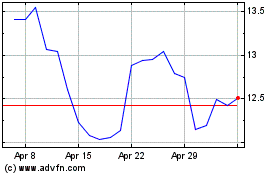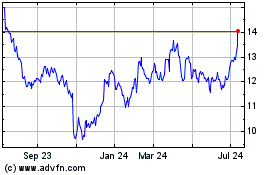By Chester Dawson, Christina Rogers and John D. Stoll
Workers at domestic car factories are reaping the benefits of
America's increasing demand for high-margin pickups and
sport-utility vehicles, with union employees expected to take home
among the biggest bonus checks ever.
The three U.S. auto makers began reporting fourth-quarter
earnings Thursday, with results showing Detroit's reliance on
light-trucks is fueling profit growth even as the wider U.S.
light-vehicle market stagnates.
The bonuses come as auto chiefs signal a willingness to consider
adding even more high-paying factory jobs on U.S. soil. Earlier in
January, Ford Motor Co. and General Motors Co. committed to nearly
2,000 new hourly positions in coming years, and Fiat Chrysler
Automotive promised to spend $1 billion to retool a pair of U.S.
factories and create 2,000 new jobs. That company's chief added on
Thursday that he would also consider bringing jobs associated with
building heavier-duty pickups from Mexico back to one of its
American factories, and hinted at the possibly of shifting
production of even more light trucks to the U.S.
Car makers are stopping short of committing to new factories in
the U.S. But optimism related to President Donald Trump's views on
easing corporate taxes, environmental regulations and other costs
of doing business that executives say are overly burdensome has car
makers reconsidering the role high-cost U.S. workers can play in
future strategy.
"The policy direction taken by Mr. Trump is something we
appreciate," said Fiat Chrysler Chief Executive Sergio Marchionne,
in a conference call with analysts on Thursday. "We have the
wherewithal now...to effectively entertain a repatriation of the
truck manufacturing back to the U.S., which has been one of the
things that has been anomalous about the this split of roles
between the U.S. and Mexico for a number of years with such a large
portion of the pickup-truck market being manufactured in
Mexico."
Factory workers aren't the only ones likely to benefit from such
a move. Shareholders, enjoying a recent increase in automotive
stock prices, are gaining from the billions of dollars in new
commitments that GM and Ford are making in dividends and share
buybacks.
UAW workers have generally pushed union leaders to first bargain
for wage gains over variable-compensation schemes. Still, Detroit
Three's 146,000 unionized factory workers -- employed in plants
mostly located in Midwestern Rust Belt states that helped secure
President Donald Trump's victory in November -- are expected to
reap the rewards of the industry's surge in U.S. sales.
Fiat Chrysler will pay out on average $5,000 in profit-sharing
based on hours worked to employees represented by the United Auto
Workers, the highest annual bonuses for its 40,000 assembly-line
workers since the company's 2009 bankruptcy.
Ford Motor's 2016 payout of $9,000 is among the highest in its
114-year history. Checks from GM -- which is reporting its results
on Feb. 7 -- will likely top the $11,000 paid last year.
Assembly workers have seen little in the way of pay raises since
the Chrysler and GM bankruptcies in 2009, but profit-sharing has
helped boost the group's spending power. The potential for bigger
bonuses have been negotiated into union contracts signed every four
years since 2007, but the awards didn't materialize until after
several years of painful restructurings.
"I'm going to pay down debt with pretty much everything I get,"
said Brian Pannebecker, a 57-year-old worker at Ford's axle plant
in Sterling Heights, Mich. He recently returned from Washington,
D.C., where he attended Mr. Trump's inauguration and bought an
expensive ticket to an inauguration ball.
Mr. Pannebecker, who faces several thousands of dollars in
credit-card balances, hopes to retire debt-free in four years.
Since 2010, when GM shed a six-year streak of annual losses, UAW
workers have collected the equivalent of $3 an hour worth of yearly
profit-sharing checks on average, representing roughly 10% of their
hourly wage.
That number is calculated based on North American automotive
earnings and is much higher for employees at Ford and GM, which
have traditionally earned at least twice as much as Fiat Chrysler
on home turf.
Some workers still have reservations about the way compensation
is now structured in the auto industry. New workers and some others
aren't expected to get the full benefit of the bonus.
Martha Gravatt, a 33-year veteran worker who transferred to
FCA's stamping plant in Warren, Mich., in 2010 when the company
shut down a factory in Twinsburg, Ohio, said she won't get the full
bonus. Ms. Gravatt said she doesn't work enough overtime to earn
her full bonus.
Fiat Chrysler worker Brian Keller isn't doing cartwheels about
the bonus payment, either. "I'd prefer to see that in our hourly
wages which would go toward my pension," said the nearly 18-year
veteran employee who works at the company's auto-parts distribution
center in Centerline, Mich.
Mr. Marchionne met with Mr. Trump earlier this week along with
chiefs from GM and Ford and came away thinking the company could
add manufacturing work in the U.S., particularly if the new
Administration carries out its pro-business agenda.
Already, the car maker has retooled its production to better
capture light-trucks profit. Fiat Chrysler is abandoning nearly all
of the company's passenger-car lines in favor of pumping out more
Ram pickups -- many imported from Mexico -- and Jeep Cherokees made
in the U.S.
Light-trucks, including Fiat Chrysler's Jeeps and Ford's
F-Series pickups now represent a record 60% of light-vehicle
sales.
Fiat Chrysler's North American operating profit -- considered a
critical barometer for an auto maker's health -- soared 15% in 2016
to EUR5.1 billion ($5.45 billion) even as revenue fell, resulting
in a 7.4% operating margin that more closely reflects those
reported by Ford and GM. More than four-fifths of the car maker's
operating profit in 2016 came from North American operations.
Fiat Chrysler on Thursday said fourth-quarter net profit doubled
to EUR409 million from a year earlier, with revenue rising 1%. Mr.
Marchionne is intent of paying down the company's debt load so that
it has at least EUR4 billion in cash net of debt by 2018.
Ford, meanwhile, swung to a net loss of $800 million in the
fourth quarter compared with $1.9 billion in net income earned in
the final three months of 2015. A 4% revenue decline and special
charges related to the company's pension plans and the cancellation
of a plant in Mexico overshadowed its strong operating results.
Write to Chester Dawson at chester.dawson@wsj.com, Christina
Rogers at christina.rogers@wsj.com and John D. Stoll at
john.stoll@wsj.com
(END) Dow Jones Newswires
January 26, 2017 17:39 ET (22:39 GMT)
Copyright (c) 2017 Dow Jones & Company, Inc.
Ford Motor (NYSE:F)
Historical Stock Chart
From Mar 2024 to Apr 2024

Ford Motor (NYSE:F)
Historical Stock Chart
From Apr 2023 to Apr 2024
